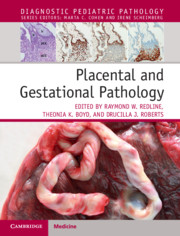Book contents
- Placental and Gestational Pathology
- Diagnostic Pediatric Pathology
- Placental and Gestational Pathology
- Copyright page
- Contents
- Contributors
- Preface
- Section 1 Introduction
- Section 2 Early Pregnancy Pathology
- Section 3 Maternal Uteroplacental-Vascular Pathology
- Chapter 5 Maternal Vascular / Trophoblastic Developmental Abnormalities
- Chapter 6 Distal Villous Hypoplasia, Focal and Diffuse
- Chapter 7 Maternal Vascular Malperfusion
- Chapter 8 Loss of Maternal Vascular Integrity
- Section 4 Fetal Stromal-Vascular Pathology
- Section 5 Inflammatory Processes
- Section 6 Other Pathologic Processes
- Section 7 Pathology of Multiple Gestations
- Section 8 Uteroplacental Pathology
- Section 9 Clinicopathologic Correlations: Placental Pathology and Adverse Pregnancy Outcomes
- Book part
- Index
- References
Chapter 8 - Loss of Maternal Vascular Integrity
from Section 3 - Maternal Uteroplacental-Vascular Pathology
Published online by Cambridge University Press: 03 September 2018
- Placental and Gestational Pathology
- Diagnostic Pediatric Pathology
- Placental and Gestational Pathology
- Copyright page
- Contents
- Contributors
- Preface
- Section 1 Introduction
- Section 2 Early Pregnancy Pathology
- Section 3 Maternal Uteroplacental-Vascular Pathology
- Chapter 5 Maternal Vascular / Trophoblastic Developmental Abnormalities
- Chapter 6 Distal Villous Hypoplasia, Focal and Diffuse
- Chapter 7 Maternal Vascular Malperfusion
- Chapter 8 Loss of Maternal Vascular Integrity
- Section 4 Fetal Stromal-Vascular Pathology
- Section 5 Inflammatory Processes
- Section 6 Other Pathologic Processes
- Section 7 Pathology of Multiple Gestations
- Section 8 Uteroplacental Pathology
- Section 9 Clinicopathologic Correlations: Placental Pathology and Adverse Pregnancy Outcomes
- Book part
- Index
- References
- Type
- Chapter
- Information
- Placental and Gestational Pathology , pp. 70 - 78Publisher: Cambridge University PressPrint publication year: 2017



